AUDI A5 COUPE 2014 Owners Manual
Manufacturer: AUDI, Model Year: 2014, Model line: A5 COUPE, Model: AUDI A5 COUPE 2014Pages: 286, PDF Size: 70.99 MB
Page 131 of 286
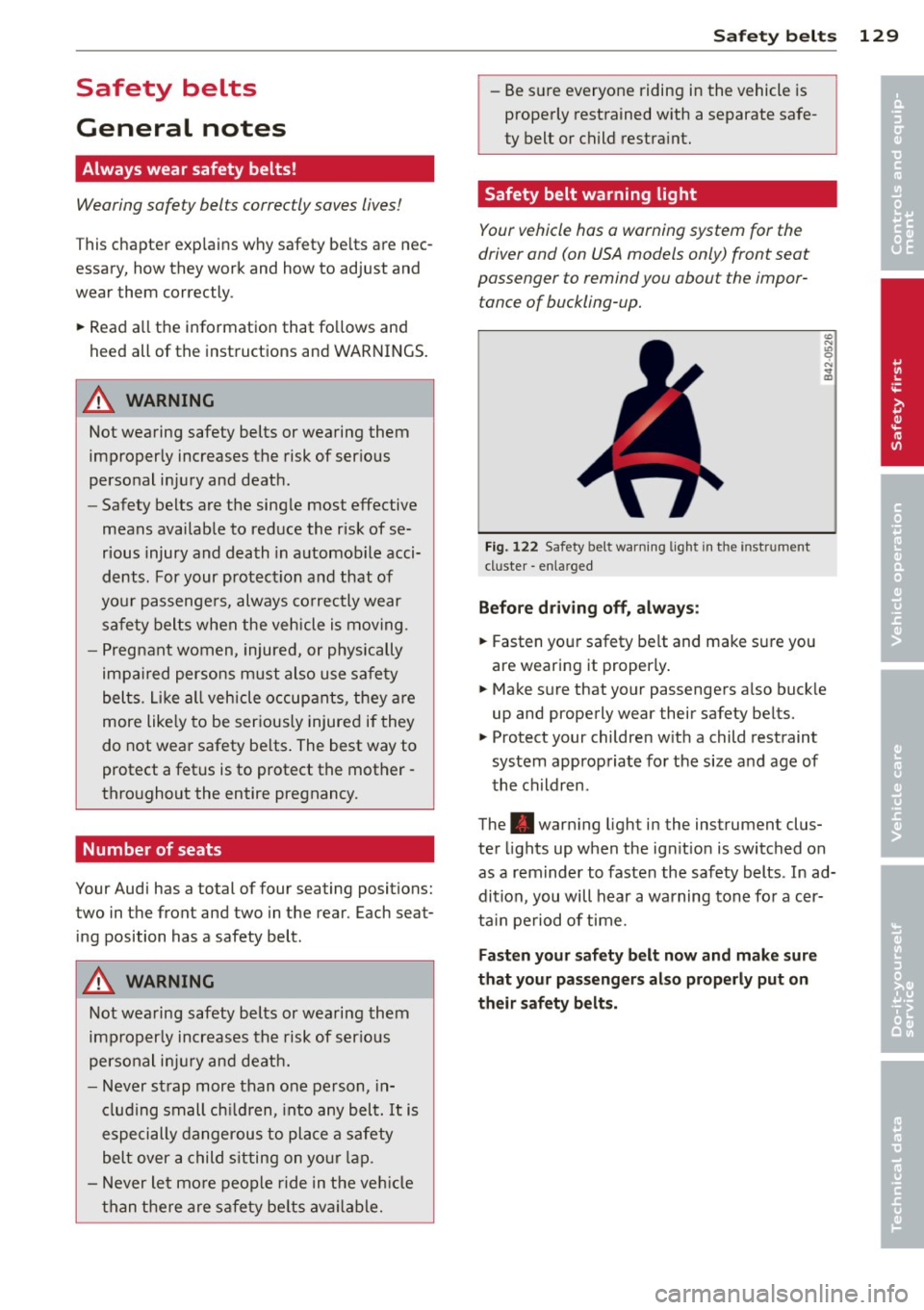
Safety belts
General notes
Always wear safety belts!
Wearing safety belts correctly saves lives!
This chapter exp lains why safety be lts are nec
essary, how they work and how to adjust and
wear them correctly.
~ Read a ll the informat ion that fo llows and
heed all of the inst ruct ions and WARNINGS.
A WARNING
Not wearing safety belts or wearing them
improperly increases the risk of ser ious
personal inj ury and death .
- Safety belts are the sing le most effective
means availab le to red uce the r isk of se
rious injury and death in a utomob ile acci
dents . For your prot ecti on and that of
yo ur passenge rs, always co rrec tly wear
sa fe ty bel ts when the ve hicle is mov ing.
- P re g nant women, injured, or physically
impai red perso ns must also use safe ty
belts. L ike a ll vehicle occup ants, they are
more like ly to be ser ious ly injure d if they
do not wea r safety be lts . The best way to
protect a fet us is to protect the mother -
thro ughout the entire pregnancy.
Number of seats
Your Audi has a total of four seating positions:
two in the front and two in the rear. Each seat
i n g position has a safety belt.
A WARNING
N ot wea ring safety belts or wea ring them
improperly increases the risk of ser ious
personal i njury an d deat h.
- Never st rap more than one pe rson, in
cl ud ing small ch ild ren, into a ny belt . It is
e speci ally dangerous t o pl ac e a safety
bel t over a child s itting on yo ur la p.
- N ever le t mo re people ride in t he ve hicle
th an there are s afe ty be lts availab le.
Safety belts 12 9
- Be s ure everyone riding in the vehicle is
properly restrained w ith a separate safe
ty belt or child restra int.
Safety belt warning light
Your vehicle has a warning system for the
driver and (on USA models only) front seat
passenger to remind you about the impor
tance of buckling-up.
Fig . 122 Safety belt warning lig ht in the instr ument
cl uster -enla rged
Before driving off, alway s:
~ Fasten your safety be lt and ma ke su re you
are wearing it properly .
~ Make sure that yo ur passengers a lso buck le
up and properly wear their safety be lts.
~ Protect your children w ith a child restraint
sys tem app ropriate fo r the size a nd age of
t h e children.
The . war ning light i n the instrument clus
te r li ghts up when the ig nition is switched on
as a reminder to fasten the safety belts . In ad
dition, you will hear a warning tone fo r a cer
ta in period of time.
Fasten your safety belt now and make sure
that your passengers al so properly put on
their safety belt s.
•
•
Page 132 of 286
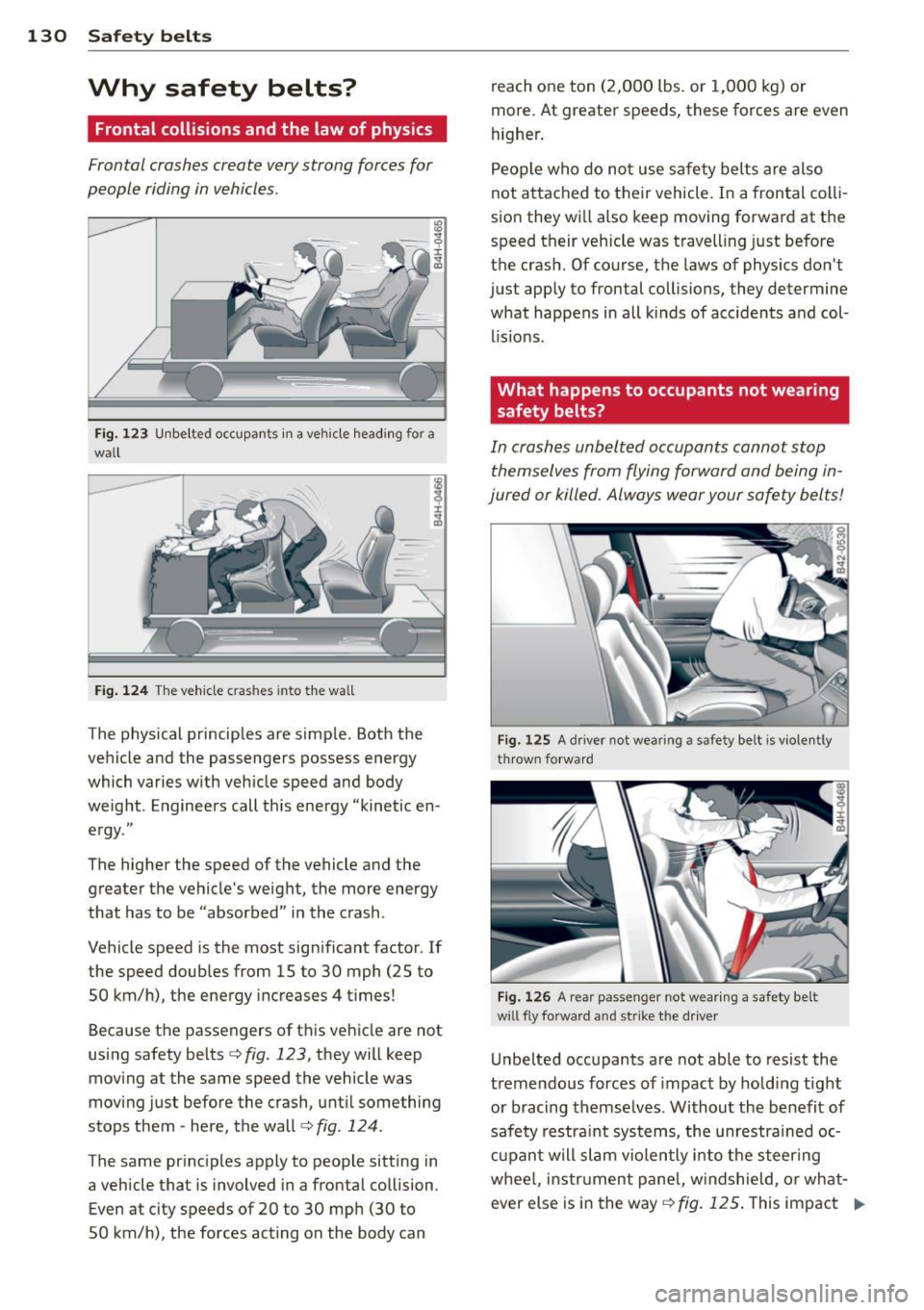
130 Safety belts
Why safety belts?
Frontal collisions and the law of physics
Frontal crashes create very strong forces for
people riding in vehicles .
Fig. 123 Unbelted occupants in a ve hicle heading for a
wall
Fig. 124 The vehicle c ras hes into the wall
The physical principles are simple. Both the
vehicle and the passengers possess energy
which varies with vehicle speed and body
weight . Engineers call this energy ''kinetic en
ergy ."
The higher the speed of the vehicle and the
greater the vehicle's weight, the more energy
that has to be "absorbed" in the crash .
Vehicle speed is the most significant factor . If
the speed doubles from 15 to 30 mph (25 to
50 km/h), the energy increases 4 times!
Because the passengers of this vehicle are not
using safety belts¢
fig. 123, they will keep
moving at the same speed the vehicle was
moving just before the crash, until something
stops them -here, the wall¢
fig. 124 .
The same principles apply to people sitting in
a vehicle that is involved in a frontal collision .
Even at city speeds of 20 to 30 mph (30 to
50 km/h), the forces acting on the body can reach
one ton (2,000 lbs. or 1,000 kg) or
more. At greater speeds, these forces are
even
higher.
People who do not use safety belts are also
not attached to their vehicle. In a frontal colli
sion they wi ll also keep moving forward at the
speed their vehicle was travell ing just before
the crash. Of course, the laws of physics don't
just apply to frontal collisions, they determine what happens in all kinds of accidents and col
lisions .
What happens to occupants not wearing
safety belts?
In crashes unbelted occupants cannot stop
themselves from flying forward and being in
jured or killed . Always wear your safety belts!
Fig. 12S A driver not wea ring a safety belt is vio len tly
t hrown forward
Fig. 126 A re ar passe nger not wearing a safety belt
w ill fl y forw ard and strike t he drive r
Unbelted occupants are not able to resist the
tremendous forces of impact by holding tight
or bracing themselves . Without the benefit of
safety restraint systems, the unrestrained oc
cupant will slam violently into the steering
whee l, instr ument panel, windshield, or what
ever else is in the way r:!>fig . 125 . This impact II>-
Page 133 of 286
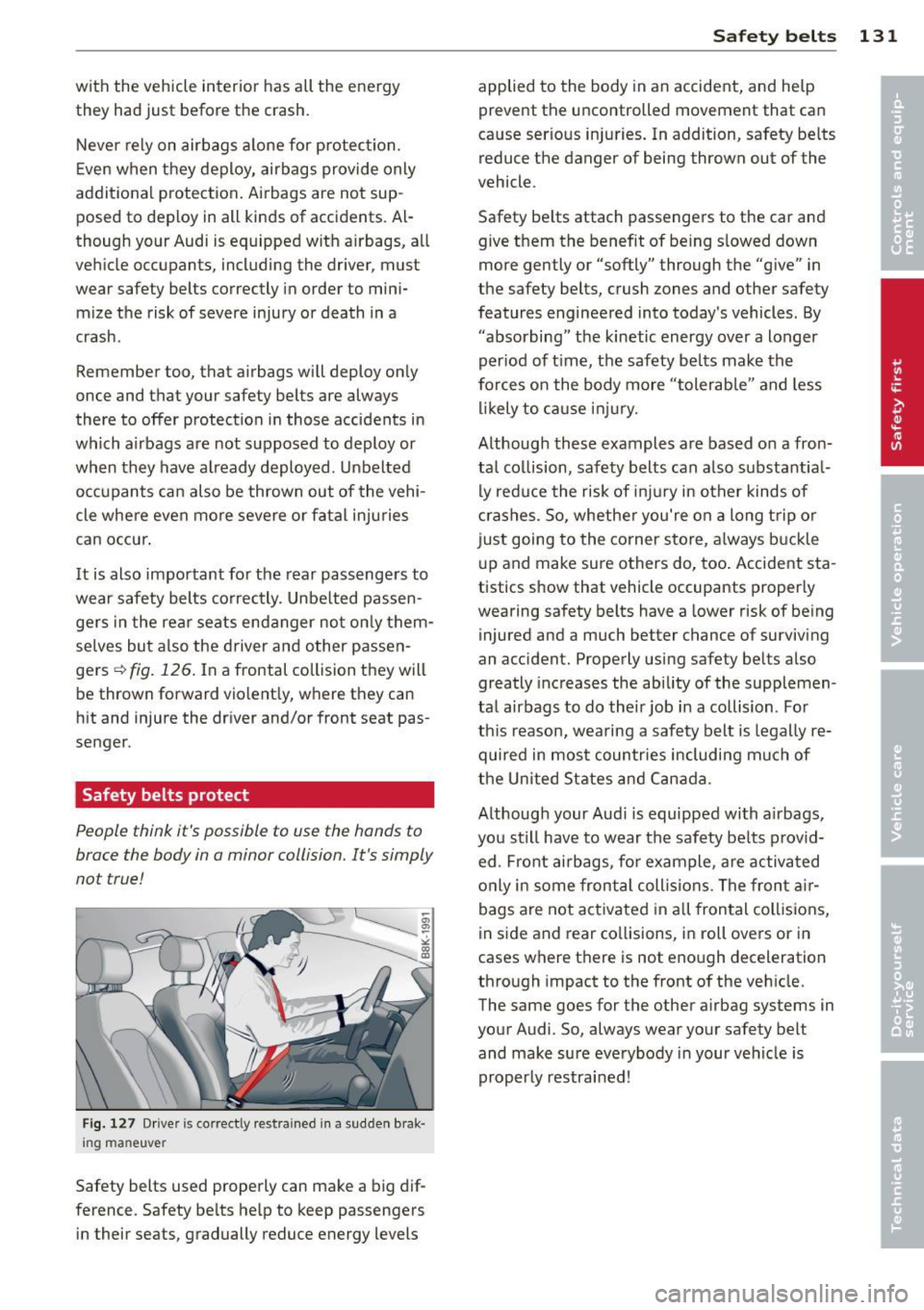
with the vehicle interior has all the energy
they had just before the crash.
Never rely on air bags a lone for protec tion.
E ven when they deploy, airbags provide only
additional protection . Ai rbags are not sup
posed to deploy in all kinds of accidents. Al
though your Audi is equipped with a irbags, all
veh icle occupants, including the driver , must
wear safety belts correctly in order to min i
mize t he risk of severe injury or death in a
crash .
Remember too, that airbags wi ll deploy on ly
once and that your safety belts are always
there to offer protection in those accidents in
which airbags are not supposed to deploy or
when they have a lready deployed . U nbelted
occupants ca n also be thrown out of the vehi
cle whe re even mo re severe o r fa tal in ju ries
can occur .
It is also impo rtant fo r the rear passenge rs to
wear safety belts co rrec tly. Unbe lted passen
ge rs i n the rea r seats endanger no t on ly them
se lves bu t also the driver a nd o ther passen
gers
¢ fig. 126 . In a frontal collision they will
be thrown forward vio lent ly, where they can
h it and injure the dr iver and/or front seat pas
senger .
Safety belts protect
People think it 's possible to use the hands to
brace the body in a minor collision. It 's simply
not true!
F ig . 127 D river is correctly restra ined in a sud den bral<·
ing maneuve r
Safety belts used properly can make a big dif
ference . Safety be lts he lp to keep passengers
in their seats, gradually reduce energy levels
Safety belts 131
applied to the body in an accident, and he lp
prevent the uncontrolled movement that can
ca use serio us injuries . In addition, safety be lts
reduce the danger of being thrown out of the
vehicle.
Safety be lts attach passengers to the car and
give t hem the benefit of being s lowed down
more gently or "softly" through the "give" in
the safety belts, crush zones and other safety
features enginee red into today's vehicles. By
"absorbing" t he kinetic energy over a longer
per iod of t ime, the safety be lts make the
fo rces on the body more "tolerable" and less
li kely to ca use inju ry.
Althoug h these examples a re based o n a fron
ta l co llision, safety belts can a lso substantia l
l y red uce the risk of in jur y in other kinds of
cr ashes. So, whethe r you're on a long trip o r
just going to the co rner store, a lways buckle
u p and make sure others do, too . Accident sta
tistics show that vehicle occupants properly
wearing safety belts have a lower risk of be ing
i njured and a much better chance of surviving
an accident. Properly using safety belts also
greatly increases the ability of the supplemen
ta l airbags to do the ir job in a collision . Fo r
th is reason, wearing a safety belt is legally re
quired in mos t coun tries including much of
t he United States and Canada.
Althoug h your Aud i is equipped wi th a irbags,
you st ill have to wear the safety be lts p rov id
ed . Front airbags, fo r example, a re activa ted
o nly in some frontal collisions. The fron t air
bags are not act ivated in a ll fron tal coll isions,
in s ide and rear co llisions, in roll ove rs or in
cases where t here is not eno ugh deceleration
through impact to the front of the veh icle.
The same goes for the other a irbag systems in
your Audi . So, always wear your safety belt
and make su re everybody in your veh icle is
properly restrai ned!
Page 134 of 286
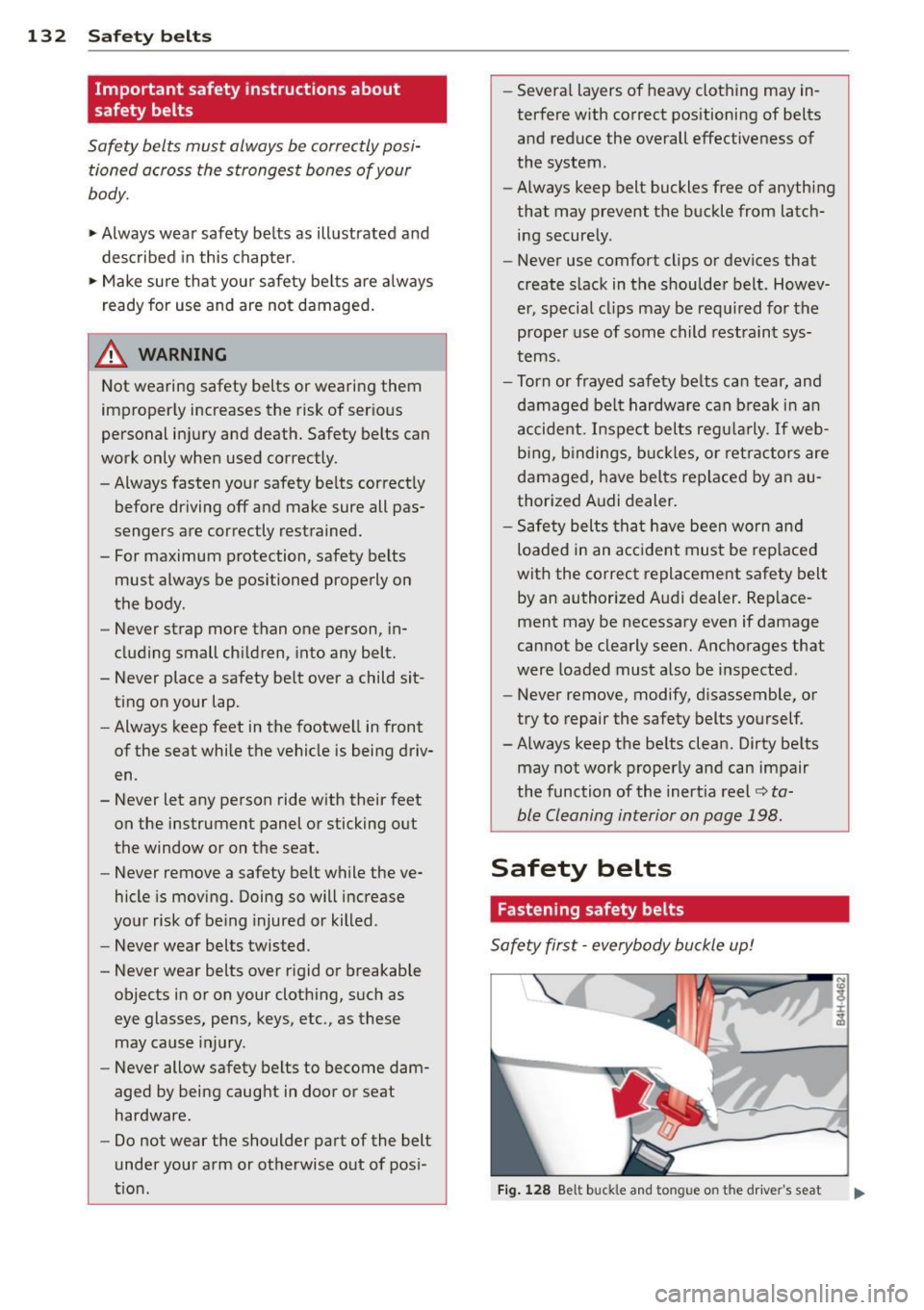
13 2 Safety belts
Important safety instructions about
safety belts
Safety belts must always be correctly posi
tioned across the strongest bones of your
body.
,.. Always wear safety belts as illustrated and
described in this chapter.
,.. Make sure that your safety belts are always
ready for use and are not damaged.
A WARNING
Not wearing safety belts or wearing them
improperly increases the risk of serious
personal injury and death. Safety belts can
work only when used correctly .
- Always fasten your safety belts correctly
before driving
off and make sure all pas
sengers are correctly restrained.
- For maximum protection, safety belts must always be positioned properly on
the body .
- Never strap more than one person , in
cluding small children, into any belt.
- Never place a safety belt over a child sit ting on your lap.
- Always keep feet in the footwell in front
of the seat while the vehicle is being driv
en .
- Never let any person ride with their feet on the instrument panel or sticking out
the window or on the seat.
- Never remove a safety belt while the ve
hicle is moving. Doing so will increase
your risk of be ing injured or killed.
- Never wear belts twisted.
- Never wear belts over rigid or breakable
objects in or on your clothing, such as
eye glasses, pens, keys, etc., as these
may cause injury.
- Never allow safety belts to become dam
aged by being caught in door or seat
hardware .
- Do not wear the shoulder pa rt of the belt
under your arm or otherwise out of pos i
tion . -
Several layers of heavy clothing may in
terfere with correct positioning of belts
and reduce the overall effectiveness of
the system .
- Always keep belt buckles free of anything
that may prevent the buckle from latch
ing securely .
- Never use comfort clips or devices that
create slack in the shoulder belt . Howev
er, special clips may be required for the
proper use of some child restraint sys
tems .
- Torn or frayed safety belts can tear, and
damaged belt hardware can break in an
accident. Inspect belts regularly .
If web
bing, bindings, buck les, or retractors are
damaged, have belts replaced by an au
thorized Audi dealer.
- Safety belts that have been worn and
loaded in an accident must be replaced
with the correct replacement safety belt
by an authorized Audi dealer. Replace
ment may be necessary even if damage
cannot be clearly seen. Anchorages that
were loaded must also be inspected.
- Never remove, modify, disassemble, or
try to repair the safety belts yourself.
- Always keep the belts clean. Dirty belts
may not work properly and can impair
the function of the inertia reel~
ta
ble Cleaning interior on page 198.
Safety belts
Fastening safety belts
Safety first -everybody buckle up!
Fig. 128 Be lt bu ckle and to ngue on t he dr iv er' s seat
Page 135 of 286
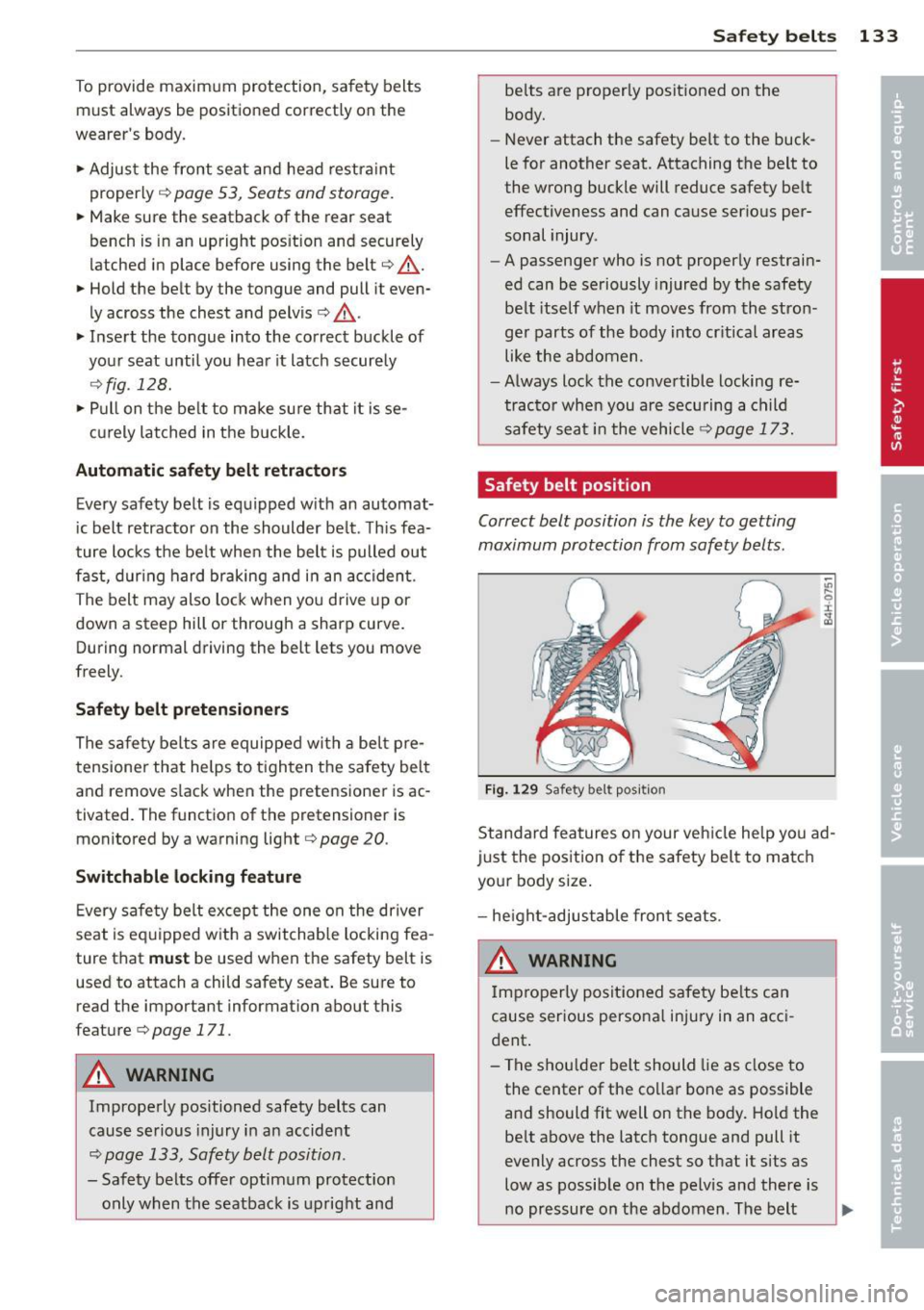
To provide maximum protection, safety belts
must always be positio ned cor rectly on the
wearer's body .
... Adjus t the front seat and head restraint
properly
r::!:> page 53, Seats and storage.
• Make sure the seatback of the rear seat
bench is in an upright pos ition and securely
latched in p lace before using the belt¢,&. .
... Hold the belt by the tongue and pull it even
ly across the chest and pelvis
r::!:> ,&. .
"" Inse rt the tongue into the co rrect buckle of
you r seat until you hea r it latch securely
r::!:> fig. 128.
•Pullon the be lt to make su re that it is se-
c u rely la tched in the buckle.
Automatic safety belt retractors
Every safety belt is equipped with an automat
ic belt retractor on the shoulder be lt . T his fea
ture locks the belt whe n the belt is pulled out
fast, dur ing hard braking and in an accident .
The belt may also lock when you drive up or
down a steep hill or through a sharp curve. During normal driving the belt lets you move
freely.
Safety belt pretensioner s
The safety belts are equipped with a be lt pre
tensioner that helps to t ighten t he safety belt
and remove s lack when the pretensioner is ac
tivated. The function of the pretensioner is monitored by a warning light¢
page 20 .
Switchable locking feature
Every safe ty belt excep t the one on the driver
seat is eq uipped with a switchable locking fea
ture that
must be used when the safety belt is
used to attach a child safety seat . Be sure to
read the important information about this
feature¢
page 171.
A WARNING
Improperly positioned safety belts can
cause se rious injury in an accident
r::!:> page 133, Safety belt position .
- Safety belts offer optimum protection
only when the seatback is upright and
Safety belts 133
be lts are proper ly positioned on the
body.
- Never attach the safety belt to the buck
le for another seat. Attaching the belt to
the wrong buckle will reduce safety be lt
effectiveness and can cause serious per
sonal injury .
- A passenger who is not properly restrain
ed can be seriously injured by t he safety
belt itself when it moves from the stron
ger parts of the body into cr itical areas
like the abdomen.
- Always lock the conve rtible locking re
tractor when you are secu ring a child
safety seat in the vehicle
r::!:> page 173.
Safety belt position
Correct belt position is the key to getting
maximum protection from safety belts .
Fig . 1 29 Safety belt pos ition
-Ill
9 :c
~
Standard features on your veh icle he lp yo u ad
just the pos ition o f the safety belt to matc h
you r body size .
- he ight-adjustable front seats.
A WARNING
Improperly positioned safety be lts can
cause serious perso na l inju ry in an acci
dent .
-
- The shou lder belt should lie as close to
the center of the co llar bone as possible
and should fit well on the body. Hold the be lt above the latc h tongue and pull it
eve nly across the chest so that it sits as
low as possib le on the pelv is and there is
no pressure on the abdomen . The belt ..,_
Page 136 of 286
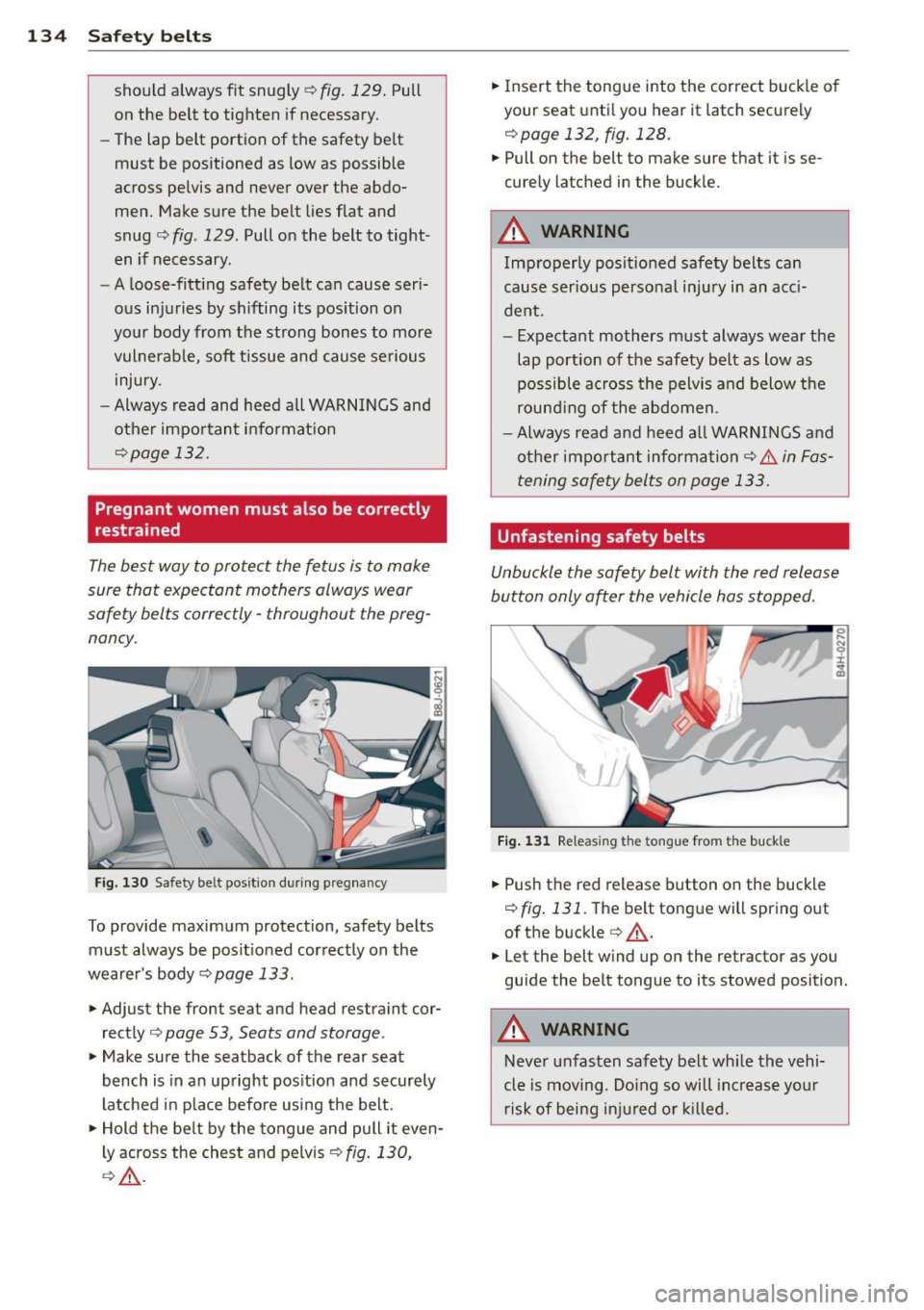
134 Safety belts
should always fit snugly¢ fig. 129. Pull
on the belt to tighten if necessary.
- The lap belt portion of the safety belt
must be positioned as low as possible
across pelvis and never over the abdo men. Make sure the belt lies flat and
snug ¢
fig. 129 . Pull on the belt to tight
en if necessary.
- A loose-fitting safety belt can cause seri
ous injuries by shifting its position on
your body from the strong bones to more
vulnerable, soft tissue and cause serious
injury .
- Always read and heed all WARNINGS and
other important information
¢page 132.
Pregnant women must also be correctly
restrained
The best way to protect the fetus is to make
sure that expectant mothers always wear
safety belts correctly -throughout the preg
nancy.
Fig. 130 Safety be lt pos it ion during p regnancy
To provide maximum protection, safety belts
must always be positioned correctly on the
wearer 's
body ¢page 133 .
... Adjust the front seat and head restraint cor
rectly ¢
page 53, Seats and storage.
... Make sure the seatback of the rear seat
bench is in an upright position and securely
latched in place before using the belt.
... Hold the belt by the tongue and pull it
even
ly across the chest and pelvis¢ fig. 130,
¢,&. .
... Insert the tongue into the correct buckle of
your seat until you hear it latch securely
¢page 132, fig. 128 .
... Pull on the belt to make sure that it is se
curely latched in the buckle.
A WARNING
Improperly positioned safety belts can
cause ser ious personal injury in an acc i
dent.
- Expectant mothers must always wear the
lap portion of the safety belt as low as
possible across the pelvis and below the
rounding of the abdomen.
- Always read and heed all WARNINGS and
other important information¢&.
in Fas
tening safety belts on page 133 .
Unfastening safety belts
Unbuckle the safety belt with the red release
button only a~er the vehicle has stopped.
Fig. 131 Releas ing t he ton gue fro m the buck le
... Push the red release button on the buckle
¢ fig. 131. The belt tongue will spring out
of the buckle ¢
,&..
... Let the belt wind up on the retractor as you
guide the belt tongue to its stowed position .
A WARNING
' "' Never unfasten safety belt while the vehi-
cle is moving . Doing so will increase your
risk of being injured or killed .
Page 137 of 286
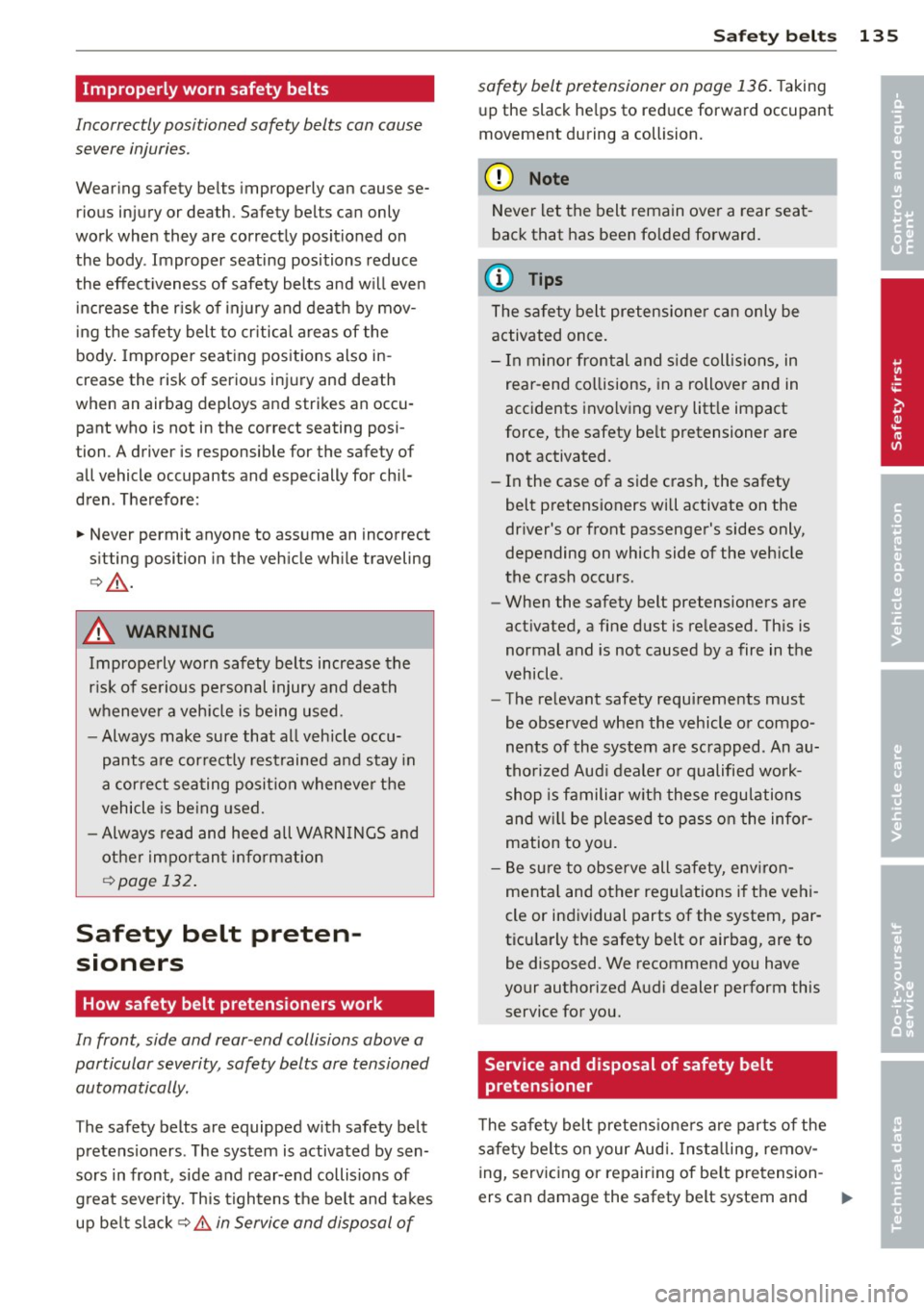
Improperly worn safety belts
Incorrectly positioned safety belts can cause
severe injuries .
Wearing safety belts improperly can cause se
rious injury or death. Safety belts can only
work when they are correctly positioned on the body . Improper seating positions reduce
the effectiveness of safety belts and will even increase the risk of injury and death by mov
ing the safety belt to critical areas of the
body . Improper seating positions also in
crease the risk of serious injury and death
when an airbag deploys and strikes an occu
pant who is not in the correct seating posi
tion . A driver is responsible for the safety of
all vehicle occupants and especially for chil
dren . Therefore:
... Never permit anyone to assume an incorrect
sitting position in the vehicle while traveling
¢ ,& .
A WARNING
Improperly worn safety belts increase the
risk of serious personal injury and death
whenever a vehicle is being used.
- Always make sure that all vehicle occu
pants are correctly restrained and stay in
a correct seating posit ion whenever the
vehicle is be ing used.
- Always read and heed all WARNINGS and
other important information
c:>page 132.
Safety belt preten
sioners
How safety belt pretensioners work
In front, side and rear-end collisions above a
particular severity, safety belts are tensioned
automatically.
The safety belts are equipped with safety belt
pretensioners . The system is activated by sen
sors in front, side and rear-end collisions of
great severity. This tightens the belt and takes
up be lt slack
c:> .&. in Service and disposal of
Safety belts 13 5
safety belt pretensioner on page 136. Taking
up the slack he lps to reduce forward occupant
movement during a collision.
Q) Note
Never let the belt remain over a rear seat
back that has been fo lded forward.
(D Tips
The safety belt pretensioner can only be
activated once.
- In minor frontal and side collisions, in
rear-end collisions, in a rollover and in
accidents involving very little impact
force, the safety be lt pretensioner are
not activated.
- In the case of a side crash, the safety
belt pretensioners will activate on the
driver's or front passenger's sides only,
depending on which side of the vehicle
the crash occurs.
- When the safety belt pretensioners are
activated, a fine dust is released. This is
normal and is not caused
by a fire in the
vehicle.
- The relevant safety requirements must
be observed when the vehicle or compo
nents of the system are scrapped. An au
thorized Aud i dealer or qualified work
shop is familiar w ith these regu lations
and will be pleased to pass on the infor
mation to you.
- Be sure to observe all safety, env iron
menta l and other regu lations if the vehi
cle or individual parts of the system, par
ticularly the safety belt or airbag, are to
be disposed. We recommend you have
your authorized Audi dealer perform this
service for you.
Service and disposal of safety belt
pretensioner
The safety belt pretens ioners are parts of the
safety belts on your Aud i. Insta lling, remov
ing, servicing or repair ing of be lt pretension-
ers can damage the safety belt system and .,.
•
•
Page 138 of 286
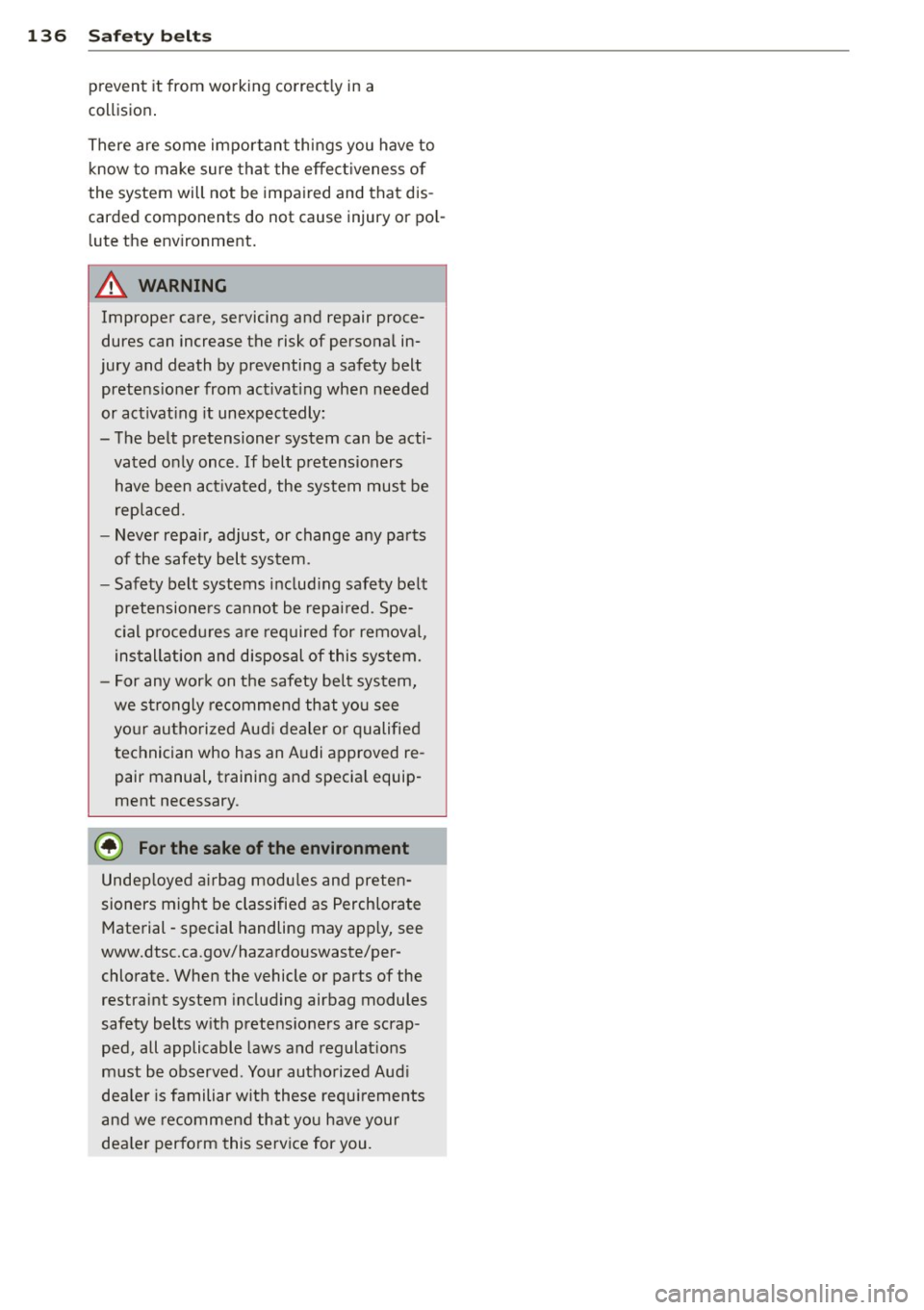
136 Safety belts
prevent it from working correctly in a
collision.
There are some important things you have to know to make sure that the effectiveness of
the system will not be impaired and that dis
carded components do not cause injury or pol
lute the environment .
.&_ WARNING
Improper care, servicing and repair proce
dures can increase the risk of personal in
jury and death by preventing a safety belt
pretensioner from activating when needed
or activating it unexpectedly:
- The belt pretensioner system can be acti
vated only once . If belt pretensioners
have been activated , the system must be
replaced.
- Never repair, adjust, or change any parts
of the safety belt system.
- Safety belt systems including safety belt
pretensioners cannot be repaired. Spe
cial procedures are required for removal ,
in5tallation and di5po5al of thi5 5y5tem.
-For any work on the safety belt system,
we strongly recommend that you see
your authorized Audi dealer or qualified
technician who has an Audi approved re pair manual, training and special equip
ment necessary.
@) For the sake of the environment
Undeployed airbag modules and preten
sioners might be classified as Perchlorate
Material - special handling may apply, see
www.dtsc.ca .gov/haza rdouswaste/per
chlorate. When the vehicle or parts of the restraint system including airbag modules
safety belts with pretensioners are scrap
ped, all applicable laws and regulations
must be observed . Your authorized Audi
dealer is familiar with these requirements
and we recommend that you have your
dealer perform this service for you .
Page 139 of 286
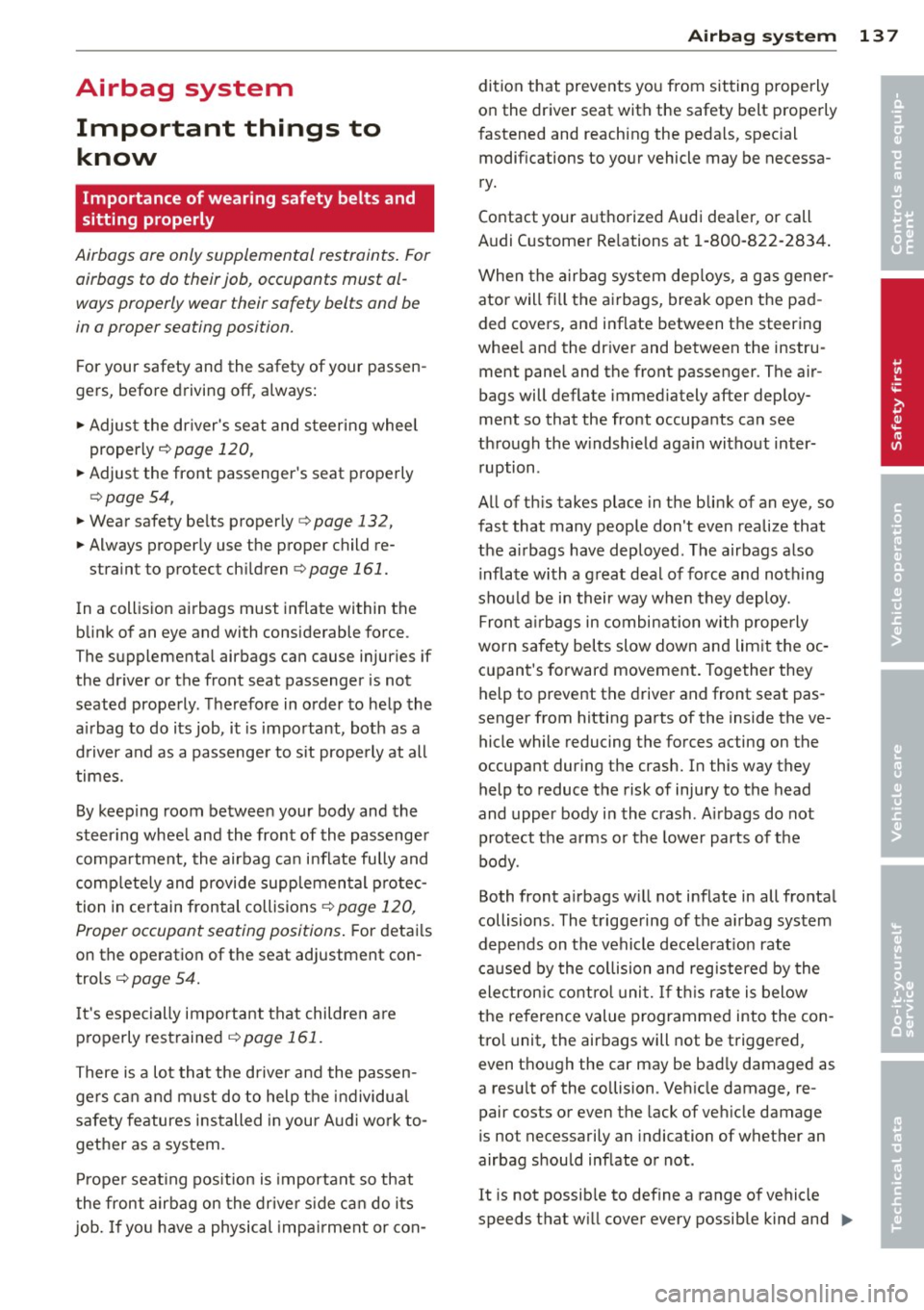
Airbag system Important things to know
Importance of wearing safety belts and
sitting properly
Airbags are only supplemental restraints. For
airbags to do their job , occupants must al
ways properly wear their safety belts and be
in a proper seating position.
For your safety and the safety of your passen
gers, before driving off, always:
"" Adjust the driver's seat and steering wheel
properly ¢
page 120,
"" Adjust the front passenger's seat properly
¢page 54,
""Wear safety be lts properly ¢ page 132,
"" Always properly use the proper child re-
straint to protect chi ldren
r::::> page 161.
In a collision airbags must inflate within th e
blink of an eye and with considerable force.
The supplemental airbags can cause injuries if
the driver or the front seat passenger is not
seated properly . Th erefore in order to help the
a ir bag to do its job, it is important, both as a
driver and as a passenge r to s it properly at all
times.
By keeping room between your body and the
steer ing whee l and the front of the passenger
compartment, the airbag can inflate fully and
comp lete ly and provide supplemental protec
tion in certain frontal collisions
r::::> page 120,
Proper occupant seating positions.
F or details
on the operation of the seat adjustment con
trols
¢ page 54.
It's especially important that children are
properly restrained
r::::> page 161.
There is a lot that the driver and the passen
gers can and must do to help the individua l
safety features installed in your Aud i work to
gether as a system.
Proper seating pos ition is important so that
the front airbag on the driver side can do its
job. If you have a physical impairment or con-
Airbag system 137
dition that prevents you from sitting properly
on the driver seat with the safety belt properly
fastened and reaching the pedals, spec ial
modifications to yo ur vehicle may be necessa
ry.
Contact your authorized Audi dea ler, or call
Audi Customer Re lations at 1-800-822-2834.
When the airbag system dep loys, a gas gener
ator will fi ll the airbags, break open the pad
ded covers, and inf late between the steering
whee l and the driver and between the instru
ment panel and the front passenger. The air
bags will deflate immediately after deploy
ment so that the front occupants can see
through the windshield aga in without inter
ruption .
All of th is takes place in the blink of an eye, so
fast that many people don't even realize that
the air bags have deployed . The airbags also
inflate with a great deal of force and noth ing
shou ld be in their way when they deploy.
Front airbags in combination with properly
worn safety belts slow down and limit the oc
cupant's forward movement. Together they
help to prevent the driver and front seat pas
senge r from hitting parts of the inside the ve
hicle while reducing the forces acting on the
occupant dur ing the crash. In this way they
help to reduce t he risk of injury to the head
and upper body in the crash . A irbags do not
protect the arms or the lower parts of the
body .
Both front air bags w ill not inflate in all frontal
collisions . The triggering of the airbag system
depends on the vehicle deceleration rate
caused by the collision and registered by the
electron ic control unit. If this rate is below
the reference value programmed into the con
trol unit, the airbags will not be triggered,
ev en though the car may be bad ly damaged as
a resu lt of the co llision . Vehicle damage, re
pair costs or even the lack of ve hicle damage
is no t necessarily an indication of whether an
airbag should inflate o r not .
It is not possib le to define a range of vehicle
speeds that w ill cover every possible kind and ..,.
•
•
Page 140 of 286
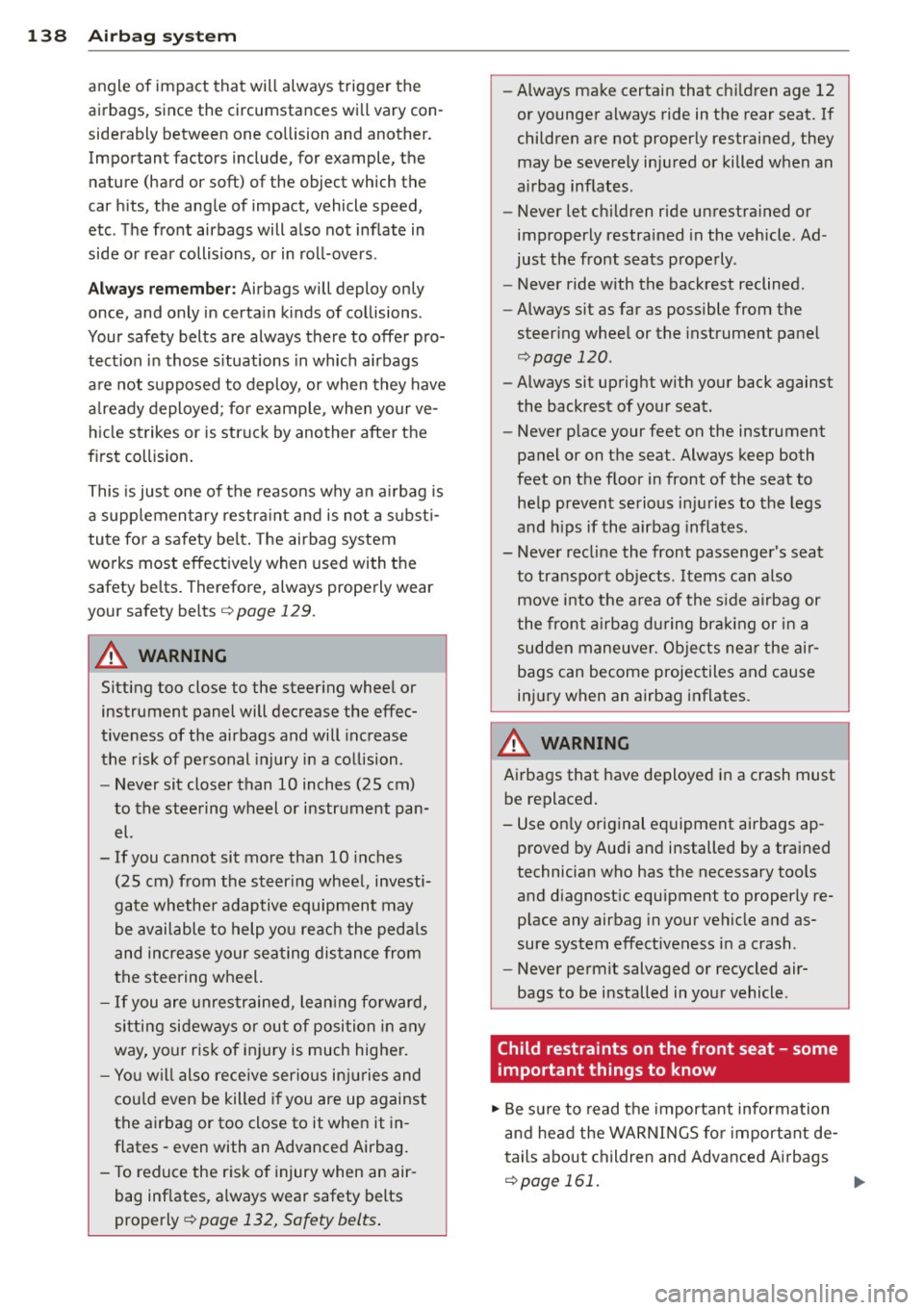
138 Airbag sys te m
angle of im pact that will always trig ger the
airbags, since the circumstances wi ll vary con
siderably between one collision and another.
Important factors include, for example, the
nature (hard or s oft) of the object which the
car h its, the angle of impact, vehicle speed,
etc. The front airbags will also not inflate in
side or re ar collisions, or in roll-overs .
Always remember : Airbags will deploy only
once, and only in certa in kinds of collisions .
Your safety belts are always there to offe r pro
tection in those s ituations in which airbags
a re not supposed to deploy , or when they have
a lready deployed; for example , when yo ur ve
h icle strikes or is st ruck by another after the
first collision .
This is just one of the reaso ns why an a irbag is
a supplementary restra int and is not a s ubst i
tute for a safety be lt. The airbag system
works most effective ly when used with the
safety be lts. Therefore, always properly wear
you r safety belts ¢
page 129 .
A WARNING
Sitting too close to the steer ing wheel or
instrument panel will decrease the effec
tiveness of the airbags and will increase
the risk of pe rsonal injury in a collision .
- Never sit closer than 10 inches (25 cm)
to the stee ring wheel or instr ument pan
el.
- If you cannot sit more than 10 inches
(25 cm) from t he steer ing wheel, investi
gate whethe r adaptive equipment may
be available to help you reach the pedals
and incre ase your sea ting dis tance from
the steering wheel.
- If you are unrestr ained, lean ing fo rward,
s itting sideways or out of posi tion in any
way, your risk of injury is much higher.
- Yo u w il l a lso receive serio us in juries and
co uld even be killed if you are up against
the airbag or too close to it when it in
flates -even with an Advanced Airbag.
- To reduce the r is k of i njury when an air
bag inf lates, a lways wear safety belts
properly
c::> page 132, Safety belts .
-Always make certain that ch ild ren age 12
or younger always ride in the rear seat. If
children are not properly restrained, they
may be severe ly injured or killed when an
airbag inflates .
- Never let c hildren ride unrestrained or
improperly restrained in the vehicle . Ad
just the front seats prope rly .
- Never ride with the back rest reclined.
- Always sit as far as possible from the
steer ing whee l or the instrument pane l
¢page 120.
-Always sit upright with your back against
the backrest of your seat.
- Never p lace your feet on the instrument
panel or on the seat. Always keep both
feet on the floor in front of the seat to
he lp prevent serious in ju ries to the legs
and h ips if the airbag inflates .
- Never recline the front passenger 's seat
to transport objects . Items can a lso
move i nto the a rea of the s ide airbag or
the front a irbag d uring br akin g or in a
sudden maneuve r. Obje cts ne ar the air
bags can become projec tiles and cause
inj ury when an airbag inflates.
.&, WARNING
A irbags that have deployed in a crash must
be replaced.
- Use on ly original eq uipment airbags ap
proved by Audi and installed by a trained
technician who has the necessary too ls
and d iagnost ic equipment to properly re
p lace any airbag in your vehicle and as
sure system effectiveness i n a crash .
- Never permit salvaged or recycled air
bags to be installed in your vehicle .
Child restraints on the front seat - some
important things to know
.,. Be s ure to read the importa nt information
and head the WAR NINGS for important de
t ails about children and Advanced A irbags
c::> page 161. ..,.